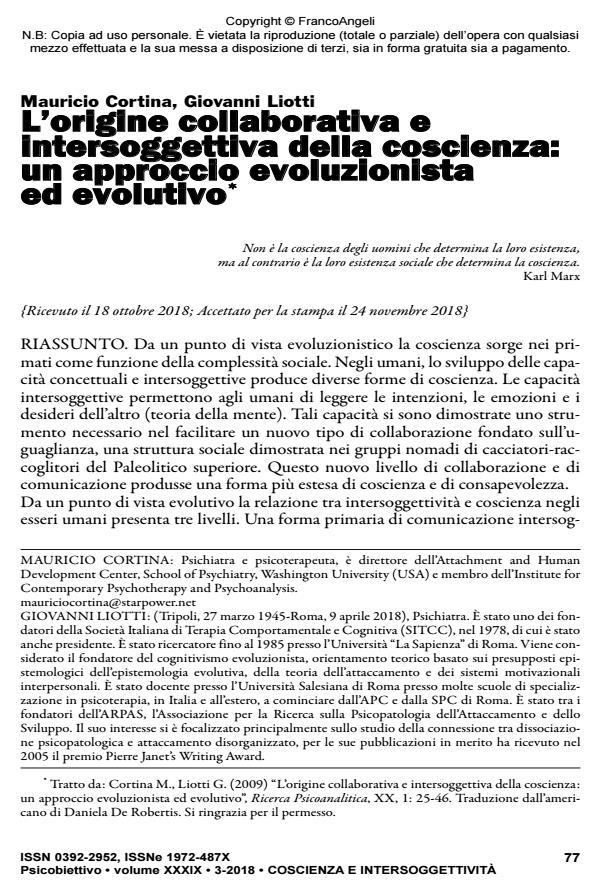The cooperative and intersubjective origin of consciousness: an evolutionist and evolutionary approach
Journal title PSICOBIETTIVO
Author/s Mauricio Cortina, Giovanni Liotti
Publishing Year 2018 Issue 2018/3
Language Italian Pages 13 P. 77-89 File size 119 KB
DOI 10.3280/PSOB2018-003008
DOI is like a bar code for intellectual property: to have more infomation
click here
Below, you can see the article first page
If you want to buy this article in PDF format, you can do it, following the instructions to buy download credits

FrancoAngeli is member of Publishers International Linking Association, Inc (PILA), a not-for-profit association which run the CrossRef service enabling links to and from online scholarly content.
Consciousness emerges in primates as a function of social complexity. As conceptual and intersubjective-communicative abilities increased in depth and breadth in humans so did different forms of consciousness. Intersubjective abilities allowed humans the capacity to read intentions, emotions and desires of others (theory of mind). These abilities might have been instrumental in facilitating a new type of cooperation based on equality that we think emerged among nomadic hunter gatherers during the upper Paleolithic era. This new level of cooperation and communication gave raise to an expanded form of consciousness and self awareness. Turning to development, we examine the relation between intersubjective communication and consciousness. Three basic levels of intersubjectivity and consciousness might be present (simultaneously) in humans. A primary form of intersubjective communication develops during the first year of life that is implicit, automatic and is limited to here-and-now and to one-to-one interactions. This form of intersubjectivity is accompanied by a core type of consciousness is not accessible for conscious scrutiny, and is probably present in most mammals. During the second year of life secondary forms of intersubjectivity expand consciousness from the immediacy of one-to-one interactions, to include a shared understanding of intentions and goals and shared exploration of the world with caregivers. The important characteristic of secondary forms of intersubjectivity is that they have access to consciousness, most likely in the form of preverbal sym bols that embody a primordial type of conceptual knowledge. This type of consciousness is probably present in most primates, particularly the apes. A further step in intersubjective communication uses the meanings and concepts that are already present, and names and expresses them in words and language. The leap into language allows our species to conceive past, present and future simultaneously (autobiographical memory). The cultural transmission of knowledge and social mores depends of these abilities. This further expands the scope of consciousness and creates conditions for self reflection, a type of consciousness that is uniquely human.
Keywords: Consciousness; Theory of Mind; Intersubjectivity; Evolutionist and Evolutionary Approach
Mauricio Cortina, Giovanni Liotti, L’origine collaborativa e intersoggettiva della coscienza: un approccio evoluzionista ed evolutivo in "PSICOBIETTIVO" 3/2018, pp 77-89, DOI: 10.3280/PSOB2018-003008